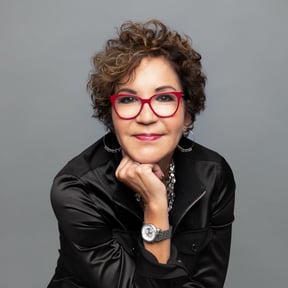Best Practices To Level Up Your
Appointment Setting Firm

Top-notch appointment setting firms run like a well-oiled machine. They earn high-quality conversations for their clients and lay the groundwork for more deals closed.
To an outside eye, they seem to run smoothly and seamlessly. And we’re left to wonder, what is their secret?
Wonder no more! There really is no “secret sauce” to having an incredible army of top-notch SDRs behind your business (whether in-house or outsourced). It comes down to an expertly crafted cocktail of thoughtful hiring, kicka** culture, and continuous learning.
Easier said than done, right? Well, almost.
We brought together the minds behind three standout appointment setting firms that are lead-ing the pack (pun intended!).
In an insightful conversation facilitated by VanillaSoft’s Head of Growth Marketing Ollie Whitfield, Nancy, Callum, and David give us a peek behind the curtain to share what makes their teams so incredible at what they do — and they just might spark some ideas for how you can take your SDR team to the next level.
Download to Read Later
Meet the Experts

Nancy Calabrese
Founder and CEO,
One of a Kind Sales
Nancy began her career in corporate recruiting before pivoting to sales with the launch of her lead generation company, One of a Kind Solutions, in 2011, which was rebranded One of a Kind Sales in 2018. She specializes in consultative selling and training teams to execute a thorough pre-sales process with an engaging approach to cold calling.

Callum Henderson
Commercial Director,
EngageIQ
Callum runs a team of talented and engaged staff who placed as the fourth best small company to work for in London. They deliver software, services, and consultancy for many companies, including eight of the top 20 tech companies in the world within the B2B tech sector. He’s currently making a real difference in sales and marketing funnels for market-leading vendors, VARs, distributors, and startups in the technology sector.

David Kreiger
President,
SalesRoads
SalesRoads began in 2007 when David proposed a remote-first appointment setting service as an entry in the Wharton School’s Business Plan Competition. Nearly 15 years later, SalesRoads is an INC 5000 company with more than 400 corporate clients, including Microsoft, Sharp, and Shell.
Hiring the right team
Building a great SDR team starts with hiring the right people. (Shocking, right? Feel free to take a moment to pick your jaw up from the floor.) Whether you’re hiring seasoned pros or young bucks, you have to know who you’re looking for and what to expect when welcoming them into the fold.
Mentorship beyond sales
 Right now, it’s a candidate’s market — we’re all just living in it.
Right now, it’s a candidate’s market — we’re all just living in it.
Though seasons ebb and flow, Callum points out that it’s a good time to be someone looking for their next role. Experienced candidates typically have multiple offers on the table, so as an employer it’s important to put your best foot forward and move quickly if you’re set on hiring someone.
If you’re hiring junior appointment-setting team members, keep in mind that you’re not just showing your SDRs the ropes of the sales world. Many of Callum’s hires have been fresh out of college. And training them doesn’t just involve teaching his team members to make sales calls, find prospects on Linkedin, or negotiate and close deals.
“You are also teaching people how to become adults, how to grow up, and how to actually operate in a professional environment,” Callum says.
Hiring junior team members demands mentorship that goes beyond sales. It requires being a leader who makes the kind of connections and investments to help them grow as people. And this is no small task!
But teaching and training junior team members can have rewarding outcomes. You get to watch them grow their skills and develop into incredible salespeople.
Moreover, if you’re a smaller company, you might not be able to offer salaries that are as high as candidates could find elsewhere. But clear and defined mentorship from an invested leadership team can be a huge benefit for candidates looking to grow early in their careers.
It’s also important to encourage young salespeople to fail fast and often. Making mistakes early is one of the best ways to learn quickly. Failure opens the door to receiving feedback and understanding what not to do in sales conversations. In turn, these experiences guide them onto the path of what to do in sales.
Hiring for experience
Perhaps you aren’t interested in hiring junior salespeople — and that’s okay too.
Maybe you’re like Nancy. She only hires people for her team who have specific experiences in outbound prospecting. She notes that plenty of people say that they are willing and able to do cold calling, but her aim is to handpick people who have lived in this world.
Keep in mind when hiring SDRs that outbound prospecting is a “no business.” SDRs have to be incredibly comfortable being rejected over and over. They need to have the resilience to persevere through endless dial tones and hang-ups from irritated or rude prospects.
But just because you hire experienced salespeople doesn’t mean they don’t need direction. Your incoming team members shouldn’t be set in their ways. Ensure that your new hires are open to being trained in a different way.
When Nancy brings new people onto the One of a Kind Sales team, she asks them to lay aside the things they’ve already learned about sales.
“Put everything you’ve learned on a shelf because you’re going to learn a different technique,” she tells them.
Willingness to learn a new way of doing things is a key distinction that sets apart a good salesperson from a great one.
What to look for when hiring
 What traits should you keep an eye out for when hiring your next SDR?
What traits should you keep an eye out for when hiring your next SDR?
One of the top items on your list should be coachability. Being able to receive feedback and apply it to your growth trajectory can make or break a salesperson. For an ever-evolving and people-focused business like sales, coachability is especially important. Each sales conversation will be a little bit different, and every prospect has unique needs. SDRs have to stay on the top of their game, adapt on the fly, and apply the most important principles of great sales conversations.
For Callum, coachability is particularly important when hiring junior salespeople because sales isn’t typically taught through formal education. So it’s unrealistic to expect someone new to the industry to have formal sales training. It’s up to the hiring manager and team to help rookies build the necessary skills and grit to succeed.
Here’s the good news: You can measure coachability during the interview process. Through a multi-stage interview and interactive tasks, you can effectively and efficiently gauge how a candidate receives and applies feedback. For example, Callum and his team include a phone task in stages 2 and 3 of their process. After a cold call roleplay in stage 2, candidates receive specific feedback, which they are expected to implement during their cold call in stage 3.
Throughout that feedback process, it’s important to look for another top trait of great salespeople: curiosity. It’s a good sign if the candidate takes notes and asks questions while receiving feedback on their cold call performance. This indicates that they are genuinely interested in the feedback and invested in their own growth.
Of course, the next signal of coachability is whether the candidate shows measurable improvement in the next stage of the interview process. Have they applied the specific feedback they’ve received so far to their next cold call simulation? Callum explains that we typically experience people on their A-game during an interview, so it can be easier to cloak weaknesses.
“In that pressured environment, if there isn’t improvement, then it's probably likely when they're in the [position] they won't [apply feedback] either,” he says.
Creating a great place to work
After you’ve hired your SDR all-stars, it’s critical to foster an environment that helps them thrive, where they love coming to work every day. This begins with the onboarding process and carries throughout the culture of your company.
Hitting the ground running
From day one, your new SDRs need to feel supported. The first days, weeks, and months are critical to grounding team members in company culture and in the expectations of their roles. This might look a little bit different for everyone. But be sure you’re equipping SDRs with the tools and training they need to succeed.
As we’ve already mentioned, appointment-setting is a “no business.” And the willingness to experience rejection and failure is a critical element of SDR work — it’s how they grow and develop. But the willingness to fail isn’t something that just happens. A new team member needs to make a conscious decision to start failing by taking risks over playing it safe.
Nancy’s take on this willingness to fail? Progress over perfection.
The first goal for new hires at One of a Kind Sales is to teach them the SDR script. Next, their leaders look for tangible performance improvements and encourage SDRs to step out of their comfort zone.
Sales is a results business. But Nancy’s philosophy is that the appointments will come.
It’s crucial for younger players to fail fast and often — so they can adapt and learn.
Another way to encourage the willingness to fail is by connecting newly hired SDRs with more experienced team members. It’s important for them to see seasoned salespeople experiencing rejections and getting hung up on repeatedly — yet still succeeding. This reminds new SDRs of the nature of the role.
Despite being a primarily remote company, Callum’s company works with new hires in person at the office for their first few months. This immerses them in the team environment and helps with their success rate.
Crafting a company culture
 It can be all too easy to water down the meaning of “company culture” to superficial perks like Friday happy hours and free coffee.
It can be all too easy to water down the meaning of “company culture” to superficial perks like Friday happy hours and free coffee.
But culture isn’t built on snacks and LaCroix. It’s about what a company values and how leaders treat their teams. In the SDR role, even the best employees get far more rejections than acceptances. (That comes with the territory.) But that means it’s all the more important to foster a culture of encouragement and celebration.
Nancy encourages her SDRs to be optimistic, focus on continuous improvement, and study their craft. She knows it’s important to keep her team motivated through all of the “nos” to get to those precious “yeses.”
Celebrate successes as a group, whether virtually over Slack or Teams or in-person with high fives and collective recognition. Rally around those who are having a particularly challenging week. Make sure your team knows they can trust their leadership and that they can look to them for both motivation and accountability.
“My team knows that I'm very fair,” Nancy says. “I may not always be able to tell them what they want to hear, but they know that they can come to me and have an honest, meaningful conversation.”
By building trust with your team, you show them they can depend on you through the rejections and the successes. And you’ll keep your SDRs around for much longer.
Continuous growth and training
We can’t overstate it: Sales is a field in which learning and growth never stop. Creating a space where SDRs receive continual training and coaching allows them to keep honing their craft — and it makes your team stronger as a whole. By having established norms and rhythms of learning together, your SDRs will see that you’re invested in them and want to keep climbing.
The training never stops
In some fields, training might be primarily a one-time onboarding process. Sales, however, is not one of those fields. Ongoing training is critical for SDR success, both individually and collectively.
This connects back to seeking out coachability during the hiring process. The best SDRs are willing to continually learn and incorporate those learnings into their sales toolbox.
But leaders must make training a priority. Build time into each week to ensure this learning happens. Use a planned hour to help your team develop their skills or learn new techniques. Selling is such a complex and human-based skill set that it’s impossible to know everything about the communication and psychology it involves.
So never sit back on your laurels and assume you know all that there is to know.
In addition to learning new skills together, training can also take place in regular huddles or one-on-ones with leadership. These kinds of connections can bring a team closer and remind SDRs that their leaders are invested in their growth. Nancy’s team uses these times to listen to call recordings, deconstruct them, and provide feedback. This allows SDRs to sharpen their skills, while everyone has their turn on the hot seat — and no one’s off the hook.
But since Nancy has taken the time to build a culture of support and motivation, her team members offer constructive criticism in a professional manner. Everyone on the team trusts each other and helps each other grow.
Coaching and community
 Continuous learning is also highly correlated with having a sense of community at work.
Continuous learning is also highly correlated with having a sense of community at work.
Callum explains that, while some people go into sales for monetary benefits or strictly professional outcomes, most salespeople have social motivations.
“The majority want to enjoy working and socializing with colleagues,” he says.
So it’s key to find a balance between fostering an environment that is fun but also encourages people to perform.
One compelling strategy: Create teams or “pods” of around 6-8 people, which allows teams to connect throughout the week and even several times a day during periodic stand-ups. Stand-ups allow the pods to incorporate brief coaching sessions, community-building exercises, or both. These connection points build trust and foster continuous growth.
Promoting incredible people
What if an SDR is ready to expand beyond their current role?
For David’s unique, specialized approach to team structure (more on that in the next chapter!), the first step is making sure they understand the frontline SDR role. When hiring from within, look for individuals who lead from the front. You’ll want to promote those who are receptive to continuous coaching and feedback.
Quarterly reviews or monthly check-ins are great opportunities to understand your team members’ motivations and career ambitions. Stay attuned to what they want to learn next.
If they are looking to move up within the team, keep an eye out for leadership qualities like answering others’ questions and giving advice. “We get a sense for whether somebody is really embodying that type of management persona because we also know that sometimes the best salespeople don't make the best managers,” says David.
Most importantly, do they fit well with your company values? This is another critical litmus test to gauge whether someone is ready to move up.
Of course, plenty of SDRs are simply hunters, David says. They love creating opportunities for clients and don’t see the role as a stepping stone to something else.
This can be a benefit of hiring SDRs later in their careers: They’re in it for the long haul.
Setting the right team structure
A lot goes into the appointment setting process. Top-notch SDR teams wear a lot of hats. How can you make sure that everything gets done? Get clear on your roles and processes. Specialization within teams can help to cover every base and ensure that everyone does their jobs incredibly well.
 SDRs wear many hats. Researching, qualifying leads, making calls, keeping lists clean — it’s all in a day’s work. And from a training perspective, it can beg the question: How can you do that many jobs well?
SDRs wear many hats. Researching, qualifying leads, making calls, keeping lists clean — it’s all in a day’s work. And from a training perspective, it can beg the question: How can you do that many jobs well?
Building your team around specializations might just be the key the helping everyone do their job that much better.
David Kreiger came to this realization several years ago. At the time, program managers did too much and struggled to focus on crucial tasks because of how many functions they had to fulfill. It was also difficult to coach and train individuals — with everyone carrying so many responsibilities, where do you even begin?
“What we realized is that we needed a team to manage and service each client,” says David.
They broke down the program manager role, and the company now operates with designated pods made up of several distinct roles. This allows each person to specialize in their role during the appointment setting process — whether client strategy, research, testing new messaging, or making calls. Now SDRs can focus on the most effective messaging and strategies possible.
Distributing specialized SDR responsibilities also benefits time management. Think about the times you’re most productive. Are they when you’re pulled in five different directions, jumping from task to task? Or are you most productive when you can deeply focus on one project at a time? Specialization within appointment setting works much the same.
Specializing SDR functions also allows for a better client experience. It ensures that no step in the process will be missed — which leads to more and better-qualified appointments and happier clients.
David describes this approach to team structure as “focusing [each member] on a piece of the SDR puzzle to deliver the best for our clients.”
You might not choose to completely restructure your team in this way. And that’s okay! But it is worthwhile to thoroughly audit each step in the appointment setting process for your team. Identify each function and ensure it correlates with the right KPI for each step in the process. Ask the question: What does my SDR team most need to be successful? Different kinds of coaching? More research support? Additional messaging testing to lock down our strategy?
When you think like a specialist, you’ll get crystal clear with and for your team members so they can do their very best work for your clients.
Conclusion: An appointment setting firm is only as good as its people.
Being thoughtful about your culture, who you hire, and how you care for them won’t just make for happier SDRs.
In the long run, it’ll mean happier clients — more and better meetings, and more closed deals.
So don’t cut corners. If you want your appointment setting firm to be one of the greats, set up your SDRs for success with the kind of support that makes them excited to come to work each day.
In a business like outbound sales, leaders that listen to their people and invest in their growth truly make all the difference.
Secrets to Running A Top Tier Appointment Setting Firm
They make it look easy, don’t they?! Some appointment setting firms just seem to have the golden touch!
So how do they do it? How are these teams so good at sales? What are the foundational best practices they’ve implemented to deliver top-notch results?
Watch on-demand as we go behind the scenes and find out what makes these firms so successful, and how you can implement their best practices within your own team.